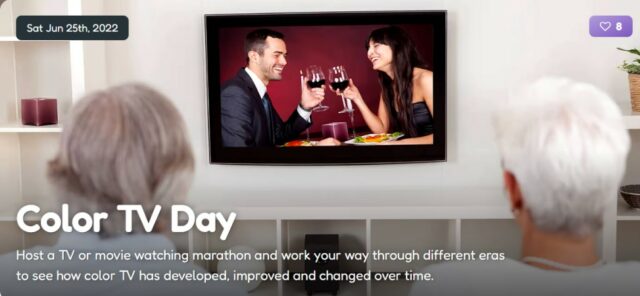
Updated March 3, 2024
Most of us take for granted watching color television, but this wasn’t always the case. It’s time to celebrate Color TV Day on June 25.
- 1876 – George Carey Has a Vision for Television. Carey, a Boston civil servant, envisions television systems, submitting plans for a selenium camera that will allow people to “see by electricity.”
- 1897 – Karl Ferdinand Braun, a German scientist, is credited with creating the cathode ray oscilloscope, which serves as a predecessor of the television image tube.
- 1904 – a German patent for a color TV system was mentioned.
- 1925 – Vladimir K. Zworkykin, a Russian inventor, filed a patent disclosure for an electronic color TV system.
- 1928 – The first working color TV system was developed by Scottish inventor, John Logie Baird in 1928.
- 1940 – Researchers at CBS invented a color television system in 1940 that was based on the 1928 mechanical TV designs of Baird.
- 1941 – The world’s first TV commercial, an advertisement for Bulova watches, aired before a Brooklyn Dodgers and Philadelphia Phillies baseball game on July 1, 1941. Lasting only 10 seconds, the ad cost the company a mere $9.
- 1942 – Another early patent for a color TV was granted in 1942 to a young Mexican inventor named Guillermo González Camarena. His patent was for an “improved chromoscopic adapter” using the “Trichromatic” system for color television transmissions.
- 1947 – Early color telecasts could be preserved only on the black-and-white kinescope process introduced in 1947.
- 1948 – While we tend to think of cable TV as a more modern invention, it’s actually almost as old as television itself. The first cable services delivered broadcast channels in three states—Oregon, Arkansas, and Pennsylvania—way back in 1948.
- 1950 – First demonstrated by CBS to the press in 1940, to the public in January 1950, and adopted as the standard for color TV by the FCC on October 11, 1950, it seemed like this newfangled device was going to be the future.
- 1950 – the Zenith Radio Corporation released the first remote control. Connected to the TV set by a bulky cord, the remote could change channels and turn the TV on and off.
- 1951 – CBS made a television program that is regarded as the first color television broadcast. The program was called Premiere and was an hour-long variety show.
- 1952 – Morning talk shows, of which modern viewers have dozens to choose from, also developed during this golden age of television. The “Today” show, created by Sylvester L. Weaver Jr. and hosted by Dave Garroway, was the first, debuting in 1952.
- 1953 – Color television would remain a bit of a dream until December 1953, when the FCC adopted RCA’s NTSC as the standard color TV technology — still the standard in the United States today.
- 1954 – The first live national TV broadcast in what was called “living color” was made in 1954 on New Year’s Day. The event was the Tournament of Roses Parade in Pasadena, California.
- 1956 – NBC began using color film to time-delay and preserve some of its live color telecasts. A company named Ampex made a color videotape recorder in 1958, and NBC used it to tape “An Evening With Fred Astaire,” the oldest surviving network color videotape.
- 1958 – there were about 350,000 color TVs in the US, mainly manufactured by RCA.
- 1958 – The first live-television breaking news event was in 1958. On Oct. 23, 1958, one of the deepest coal mines in the world collapsed in Springhill, Nova Scotia. Ninety-three men were trapped belowground, desperately attempting to dig their way out just as rescuers attempted to dig their way in.
- 1958 – President Dwight D. Eisenhower visited the NBC station in Washington, D.C. and gave a speech discussing the new technology’s merits. His speech was recorded in color, and a copy of this videotape was given to the Library of Congress.
- 1960 – The cost of a color TV in 1960 was approximately $300 – equivalent to $3.26 today!
- 1961 – September of 1961 was a turning point for the purchases of color television when the Walt Disney show “The Wonderful World of Color” made its debut appearance.
- 1962 – The first cartoon shows shown in color were in the fall of 1962 – The Flintstones and The Jetsons.
- 1966 – all of the news on NBC was shown in color.
- 1966 – The first television season when all three major networks showed their Prime-time TV lineups in color was the 1966-67 season.
- 1972 – there were more color televisions than black and white TVs in the USA.
- Daytime soap operas were some of the last shows to switch over to color.
- The cost of the first color TV for consumers was expensive! The model was an RCA set with a 15-inch screen which sold for $1.000 (comparable to $7850 today!)
- The production of color TVs was stopped during the Korean war because metals needed for the war which were also needed to produce color TVs was scarce.
- The Perry Mason TV series experimented with just one episode in color.
- Many early TV shows switched over to color partway through their runs. Lost in Space had three seasons but only seasons 2 and 3 were filmed in color.
- The moon landing tapes have all been lost. NASA employees believe that these original tapes were likely wiped clean and used again, which was standard practice at the time.
- It is no longer possible to buy a new black-and-white set, though many are still offered for sale on sites such as Gumtree and eBay.
Sources:
Disclaimer
The information contained in South Florida Reporter is for general information purposes only.
The South Florida Reporter assumes no responsibility for errors or omissions in the contents of the Service.
In no event shall the South Florida Reporter be liable for any special, direct, indirect, consequential, or incidental damages or any damages whatsoever, whether in an action of contract, negligence or other tort, arising out of or in connection with the use of the Service or the contents of the Service. The Company reserves the right to make additions, deletions, or modifications to the contents of the Service at any time without prior notice.
The Company does not warrant that the Service is free of viruses or other harmful components












